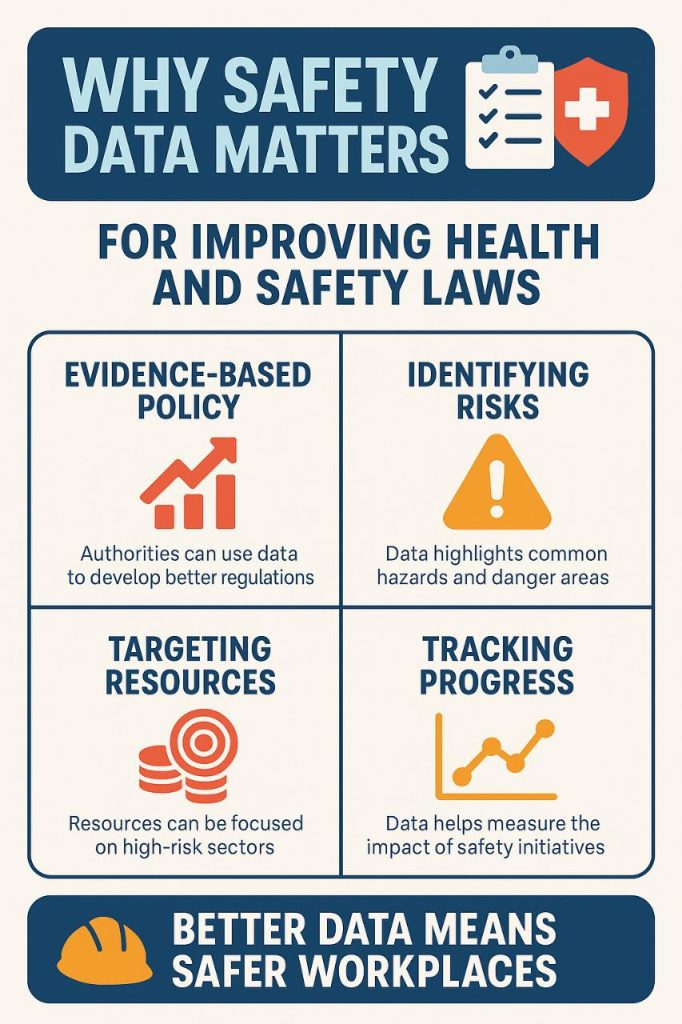Why Workplace Safety Data Matters for Strengthening Pakistan’s Health and Safety Laws
Why Workplace Safety Data Matters for Strengthening Pakistan’s Health and Safety Laws
Introduction
Workplace safety is not only a moral responsibility but also an essential pillar of sustainable economic growth. Every year, thousands of Pakistani workers suffer injuries, illnesses, or fatalities at their workplaces—whether in factories, construction sites, mines, or public sector enterprises. Yet, one of the greatest obstacles to improving occupational health and safety (OHS) in Pakistan is the absence of comprehensive, reliable, and timely data on workplace incidents.

Without accurate data, policymakers and regulators cannot fully understand the scope of hazards, industry-specific risks, or the economic burden of unsafe workplaces. As a result, laws remain outdated, enforcement inconsistent, and preventative measures weak. This article explores why workplace safety data is vital, how the Government of Pakistan can build systematic reporting mechanisms, and how such efforts can drive stronger OHS laws and standards in line with international best practice
Historical Context: Where Pakistan Stands
Workplace safety has long been a neglected area in Pakistan’s governance. Historically, colonial-era laws such as the Factories Act of 1934 and the Mines Act of 1923 set the foundation for safety standards, but these were designed for an industrial landscape very different from today’s complex and diverse economy.
After devolution under the 18th Constitutional Amendment (2010), responsibility for labor and safety largely shifted to provincial governments. This created both opportunities and challenges: provinces like Punjab and Sindh introduced their own labor and factories acts, but the fragmentation also made national-level data collection more difficult.
Tragic industrial disasters highlighted the gaps:
- The Baldia Town Factory Fire (Karachi, 2012), which killed over 250 workers, exposed serious shortcomings in factory inspections, safety audits, and worker rights.
- Mining accidents in Balochistan (such as the Marwar coal mine collapse in 2018) repeatedly underscored the lack of monitoring and data transparency.
- More recently, Pakistan’s construction boom has brought frequent, but often under-reported, falls, electrocutions, and scaffold collapses.
These incidents demonstrate the human and economic toll of weak safety systems—but without reliable data, it is impossible to quantify the true cost or design effective laws.

Why Safety Data is Crucial
1. Evidence-Based Policymaking
Safety laws cannot be improved in a vacuum. Data on the number, type, and cause of incidents provides lawmakers with the evidence needed to draft regulations that target the most pressing risks. For example, if data shows a spike in crane-related injuries in construction, new standards on crane safety, licensing, and inspections can be introduced.
2. Setting National Priorities
Resources for inspections, training, and enforcement are always limited. Safety data helps the government prioritize high-risk industries (e.g., mining, construction, chemicals) rather than spreading enforcement thinly across all sectors.
3. Monitoring Progress
Accident data provides benchmarks. If laws are reformed or new training campaigns launched, data shows whether these interventions actually reduce incidents over time.
4. International Reporting and Trade
International bodies like the ILO (International Labour Organization) require reporting on workplace injuries and fatalities. Countries that maintain transparent safety data strengthen their credibility, attract responsible foreign investors, and avoid reputational damage in global supply chains.
5. Economic Justification
Workplace injuries reduce productivity, increase healthcare costs, and strain social protection systems. Reliable data enables economists and policymakers to calculate the financial burden of accidents and justify investments in safety reforms.
Current Challenges in Pakistan’s Safety Data System
- Under-reporting: Many employers hide accidents to avoid inspections, penalties, or compensation claims.
- Informal Sector Gaps: A large portion of Pakistan’s workforce is employed in the informal economy (e.g., small workshops, agriculture, transport), where accidents are rarely documented.
- Fragmented Jurisdiction: Provincial labor departments lack standardized formats for reporting. This prevents aggregation at the national level.
- Weak Institutional Capacity: Labor inspectorates are underfunded and understaffed; inspection records are often paper-based and poorly archived.
- Cultural Barriers: Workers fear reprisals for reporting accidents, while employers view safety as a cost rather than an investment.
How the Government Can Improve Safety Data Collection
1. Legally Mandate Reporting Systems
Introduce a national law requiring businesses above a certain size to report all workplace incidents and near-misses. Penalties for non-reporting must be clear and enforceable.
2. Digital Reporting Platforms
Develop centralized, digital platforms where companies can submit safety incident reports online. These could be hosted by provincial labor departments but linked to a federal OHS database managed by the Ministry of Overseas Pakistanis and Human Resource Development.
3. Integrate Public Sector Enterprises
Government-owned enterprises (e.g., OGDCL, WAPDA, Pakistan Railways) must also be bound by mandatory reporting rules. As large employers, their data would significantly improve national statistics.
4. Capacity Building for Inspectorates
Train and equip provincial labor inspectors with mobile devices and data collection tools, ensuring real-time uploads of inspection findings and accident reports.
5. Worker-Driven Reporting Channels
Establish anonymous hotlines or mobile apps where workers can directly report unsafe conditions or accidents without fear of retaliation.
6. Partnership with Academia and NGOs
Universities and research institutes can help analyze safety data, while NGOs can act as watchdogs to ensure transparency.
7. Harmonize Across Provinces
Develop a National Occupational Safety & Health Framework that sets minimum standards for data collection and reporting formats across all provinces. This ensures comparability and allows a consolidated national database.
Leveraging Data to Improve Standards
Once data begins to flow, it can be used to:
- Identify Industry Trends: Recognize which sectors have the highest accident rates.
- Develop Sector-Specific Codes: Tailor safety standards for high-risk sectors like mining, textiles, and construction.
- Launch Awareness Campaigns: Use data insights to target safety training where it is needed most.
- Strengthen Enforcement: Allocate inspection resources strategically, focusing on workplaces with repeated accidents.
- Encourage Corporate Responsibility: Publicly ranking or scoring companies on their safety records can push businesses to self-improve.
Learning from International Examples
- United States: The OSHA (Occupational Safety and Health Administration) maintains a nationwide database of workplace injuries and fatalities, accessible for public research.
- UK: The Health and Safety Executive (HSE) publishes annual reports with detailed accident data, guiding continuous policy improvement.
- Bangladesh: After the Rana Plaza disaster in 2013, Bangladesh implemented stronger reporting and inspection systems under international pressure—leading to measurable improvements in factory safety.
Pakistan can adapt lessons from these systems while considering its local context.
Conclusion
Workplace safety is inseparable from national development. In Pakistan, thousands of preventable deaths and injuries occur each year in silence, simply because they are not systematically recorded. Without data, policymakers are left to guess; with data, they can legislate wisely, enforce effectively, and protect workers’ lives. The path forward requires a cultural shift in how safety is viewed—not as a burden, but as an investment in human capital and economic resilience. By mandating, digitizing, and harmonizing safety data collection across provinces and sectors, Pakistan can build the foundation for robust occupational health and safety laws that save lives, improve productivity, and align the country with global labor standards.




2 Comments